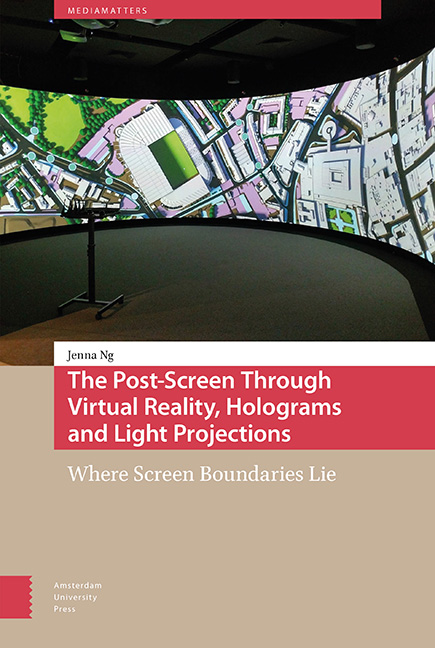 The Post-Screen through Virtual Reality, Holograms and Light Projections
The Post-Screen through Virtual Reality, Holograms and Light Projections Book contents
- Frontmatter
- Dedication
- Table of Contents
- Acknowledgements
- Introduction
- 1 Screen Boundaries as Movement
- 2 Leaking at the Edges
- 3 Virtual Reality: Confinement and Engulfment; Replacement and Re-placement
- 4 Holograms/Holographic Projections : Ghosts Amongst the Living; Ghosts of the Living
- 4A (Remix) True Holograms: A Different Kind of Screen; A Different Kind of Ghost
- 5 Light Projections: On the Matter of Light and the Lightness of Matter
- Conclusion/Coda
- Index
3 - Virtual Reality: Confinement and Engulfment; Replacement and Re-placement
Published online by Cambridge University Press: 16 December 2021
- Frontmatter
- Dedication
- Table of Contents
- Acknowledgements
- Introduction
- 1 Screen Boundaries as Movement
- 2 Leaking at the Edges
- 3 Virtual Reality: Confinement and Engulfment; Replacement and Re-placement
- 4 Holograms/Holographic Projections : Ghosts Amongst the Living; Ghosts of the Living
- 4A (Remix) True Holograms: A Different Kind of Screen; A Different Kind of Ghost
- 5 Light Projections: On the Matter of Light and the Lightness of Matter
- Conclusion/Coda
- Index
Summary
Abstract
This chapter explicates Virtual Reality (VR) as the first instantiation of the post-screen. Specifically, it interrogates VR's sense of immersion via two vectors in the post-screen's “forgetting” of screen boundaries – confinement of a viewer's visual field with restricted viewing devices; and engulfment by being surrounded with large screens. The chapter's key idea is its alternative expression of VR's relations of reality as an immersive media form, which it argues shifts from the critical paradigms of replacement to re-placement. Through theoretical critique and readings of various applications of VR, the chapter argues for re-placement as a more ethical and generative space for thinking through VR's relations of the real. In turn, where and how the actual and the virtual is re-placed informs the very purpose of media itself.
Keywords: virtual reality; replacement; re-placement; immersion; simulacra; totalization
“Multitudes of Amys”
Multitudes of Amys
Ev’rywhere I look
Sentences of Amys
Paragraphs of Amys
Filling ev’ry book
∼ Stephen SondheimThe lines above are lyrics from a love song. Written by Stephen Sondheim for the acclaimed 1970 Broadway comedy musical, Company, “Multitudes of Amys” was to mark the moment the protagonist, a bachelor named Robert who had been unable to commit to a relationship, realizes he is in love with Amy. What is interesting for our purposes is how Robert sings of his love not as an emotion but an omnipresence – his being in love is to be surrounded by “multitudes,” or to see and hear his object of affection everywhere he looks. The grand emotion of love replaces Robert's everyday reality with sights of Amy – “I see them waiting for the lights, running for the bus, milling in the stores” – and sounds of her: “choruses of Amys, symphonies of Amys, ringing in my ear.” Robert is not only in love, he is also in love, as if sunk into a vat of it. He is immersed.
Conceptually, the sentiment of “Multitudes of Amys” is miles from the experience of Virtual Reality (VR) as the focus of this chapter. Yet it might appear that love and VR bear surprising similarities – VR, too, is an immersion in, we can say, multitudes of virtual reality, or reality that is real yet fabricated.
- Type
- Chapter
- Information
- The Post-Screen through Virtual Reality, Holograms and Light ProjectionsWhere Screen Boundaries Lie, pp. 107 - 154Publisher: Amsterdam University PressPrint publication year: 2021
